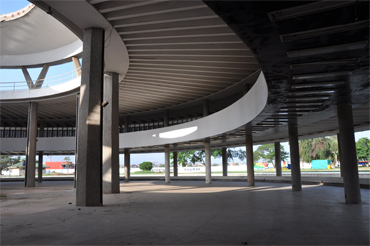
Transnational Architecture Practice in Africa, Asia, and the Middle East, 1960s-1980s. Session, 66th Annual Conference in Buffalo, NY, April 10-14, 2013
Session chairs: Max Hirsh (Post-Doctoral Research Fellow, ETH Zurich, Future Cities Laboratory Singapore) and Łukasz Stanek (A. W. Mellon Post-Doctoral Fellow, CASVA, Natonal Gallery of Art, Washington, D.C.)

International Trade Fair Accra (Ghana), Jacek Chyrosz & Stanisław Rymaszewski, completed in 1967. Pic. Łukasz Stanek (2012).
This panel investigates the transnational transfer of architectural knowledge from the 1960s to the 1980s in Africa, Asia, and the Middle East. Encouraged by rapid growth in the developing world, and facilitated by the expansion of international banking and communication systems, many architects, firms, and design schools began exporting their expertise beyond their familiar cultural sphere. Working abroad offered architects the opportunity to realize their formal, technical, and programmatic ambitions--but also demanded a reformulation of existing modes of design, research, and project management. While fundamentally driven by post-colonial conditions within the framework of the Cold War, these transfers often did not conform to broader geopolitical logics: with Japanese firms designing luxury hotels in East Germany, Polish architects working in Iraq, Ghana and the UAE, and Swiss pedagogues formulating design curricula in Mainland China. Moreover, countries like Libya and Singapore recombined architectural principles from many sources, leading to highly syncretic design practices.
Investigating the interaction between local clients and foreign designers, engineers, and military personnel, the panel invites papers that ask how practitioners engaged with politically, geographically, and culturally dissonant operating environments. Papers might focus on the challenges and innovations that arose from the dissemination of specific building technologies, design tools, prefabricated systems, regulatory norms, aesthetic preferences, modes of representation, or teaching methods. They could probe the activities of an individual architect, firm, or design school; or examine the role of institutional networks and informal kinship relations in cross-border negotiations. Emphasizing the heterogeneous nature of the shifts in architectural production and architect-client relations, the panel proposes to investigate the immediate origins of the ongoing globalization of architectural practices.
Program:
2:00 p.m. Introduction by Max Hirsh and Łukasz Stanek
2:10 p.m. Architecture and International Development Aid in Postcolonial Africa, Kim De Raedt, University of Ghent
2:35 p.m. Non-Aligned Architecture: China’s Designs on/in Africa, 1955–1989, Cole Roskam, University of Hong Kong
3:00 p.m. Architectural Expertise and Transnational Networks in Maputo, 1960–1987, Nikolai Brandes, Freie Universität Berlin
3:25 p.m. Tefen and the Liberal Model in Israeli Architecture, 1977–85, Dan Handel, Technion-Israel Institute of Technology, and Alona Nitzan-Shiftan, Technion-Israel Institute of Technology
3:50 p.m. Australian Trained Architects and the Building of Cold War Asia, Peter Scriver, University of Adelaide, and Amit Srivastava, University of Adelaide
4:15 p.m. Discussion/Q&A
4:30 p.m. Closure of Session




